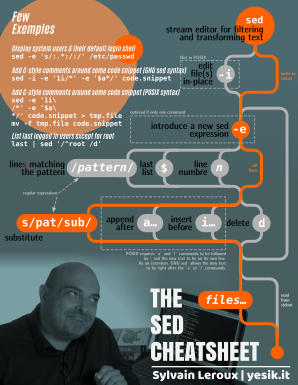sed -e 's/:.*:/:/' /etc/passwd

The Sed Cheatsheet
I’ve drawn that railroad-style infographic so you can have all in one page the basic syntax of the sed command.
Just start at the top of the page with the sed command, and follow the tracks, choosing the option you need at each intersection. For example:
-
To display system users & their default login shell, you will write:
The substitution command will tell _sed_ to replace any text between the first and the last colon of each line by a single colon -- effectively removing any content between colons of the original file. The original file remains unchanged, and the output is sent to the standard output (the terminal)
-
To list last logged in users except for root, you will write:
last | sed '/^root /d'
A really common use of _sed_ in being part of a pipeline. Here I use it to filter out -- using the (d)elete command -- all lines starting by the word `root` (`^` means the start of the line).
-
To add C-style comments around some code snippet, you will write:
sed -i -e '1i/*' -e '$a*/' code.snippet
or, using only the POSIX syntax:
sed -e '1i\ /*' -e '$a\ */' code.snippet > tmp.file mv -f tmp.file code.snippet
The (i)nsert command add text _above_ the selected line. And the (a)ppend command adds text _after_ it. Among other improvements, GNU sed adds the `-i` option to change files in place (instead of manually creating temporary files). And the `i` and `a` commands can be written in only one line.